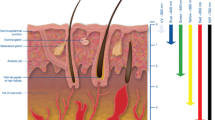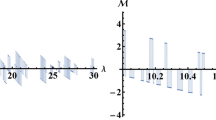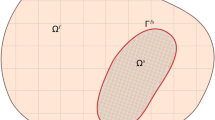Abstract
The objective of this paper is to develop a computational model and corresponding solution algorithm to enable rapid simulation of laser processing and subsequent targeted zonal heating of materials composed of packed, discrete, particles. Because of the complex microstructure, containing gaps and interfaces, this type of system is extremely difficult to simulate using continuum-based methods, such as the Finite Difference Time Domain Method or the Finite Element Method. The computationally-amenable model that is developed captures the primary physical events, such as reflection and absorption of optical energy, conversion into heat, thermal conduction through the microstructure and possible phase transformations. Specifically, the features of the computational model are (1) a discretization of a concentrated laser beam into rays, (2) a discrete element representation of the particulate material microstructure and (3) a discrete element transient heat transfer model that accounts for optical (laser) energy propagation (reflection and absorption), its conversion into heat, the subsequent conduction of heat and phase transformations involving possible melting and vaporization. A discrete ray-tracking algorithm is developed, along with an embedded, staggered, iterative solution scheme, which is needed to calculate the optical-to-thermal conversion, particle-to-particle conduction and phase-transformations, implicitly. Numerical examples are given, focusing on concentrated laser beams and the effects of surrounding material conductivity, which draws heat away from the laser contact zone, thus affecting the targeted material state.









Similar content being viewed by others
Notes
In addition, there can be possible concerns with overheating the laser device itself.
Resolving diffraction (which ray theory is incapable of describing) is unimportant for the applications of interest.
The free space electric permittivity is \(\epsilon_{o}=\frac{1}{c^{2}\mu_{o}}=8.8542\times10^{-12}~\mbox{C}\, \mbox{N}^{-1}\,\mbox{m}^{-1}\) and the free space magnetic permeability is μ o =4π×10−7 Wb A−1 m−1=1.2566×10−6 Wb A−1 m−1.
By combining the relations in (2.5) one obtains \(\|\boldsymbol{k}\|=\frac{\omega}{c}\).
Throughout the analysis we assume that \(\hat{n}\ge1\).
The limiting case \(\frac{\sin\theta^{*}_{i}}{\hat{n}}=1\), is the critical angle (\(\theta^{*}_{i}\)) case.
\(\mathbb{K}_{ij}\) is approximated by the average interfacial value of the i−j pair, \(\mathbb{K}_{ij}\approx\frac{\mathbb{K}_{i}+\mathbb{K}_{j}}{2}\).
In the idealized limit, the temperature would be constant.
We repeatedly refined the “ray density” up to 10000 rays and found no significant difference compared to the 1000 ray result.
In order to adequately compare between different tests in Table 1, the same random 1000 particle ensemble was used each time.
To achieve this distribution, we first placed rays randomly in the plane, and then scaled the individual I inc by e −ad and the normalized the average so that the total was 6000 W.
For an early history of the printed electronics field, see Gamota et al. [23].
In such applications, lasers can be used to heat treat and dry particle-based inks.
This is a more general case than the one considered in (7.2) where \(\varPhi(t-\varLambda(\boldsymbol{x} ))=e^{j(k_{o}S(\boldsymbol{x})-\omega t)}\).
References
Ahmad Z, Rasekh M, Edirisinghe M (2010) Electrohydrodynamic direct writing of biomedical polymers and composites. Macromol Mater Eng 295:315–319
Alivisatos P (2004) The use of nanocrystals in biological detection. Nat Biotechnol 22(1):47–52
Allwood J (2005) What is sustainable manufacturing? Lecture, Cambridge University
Carbonell JM, Onate E, Suarez B (2010) Modeling of ground excavation with the particle finite element method. J Eng Mech 136:455–463
Choi S, Park I, Hao Z, Holman HY, Pisano AP, Zohdi TI (2010) Ultra-fast self-assembly of micro-scale particles by open channel flow. Langmuir 26(7):4661–4667
Choi S, Stassi S, Pisano AP, Zohdi TI (2010) Coffee-ring effect-based three dimensional patterning of micro, nanoparticle assembly with a single droplet. Langmuir 26(14):11690–11698
Choi S, Jamshidi A, Seok TJ, Zohdi TI, Wu MC, Pisano AP (2012) Fast, high-throughput creation of size-tunable micro, nanoparticle clusters via evaporative self-assembly in picoliter-scale droplets of particle suspension. Langmuir 28(6):3102–3111
Cerveny V, Molotkov IA, Psencik I (1977) Ray methods in seismology. Univerzita Karlova, Praha
Davis SH (2001) Theory of solidification. Cambridge University Press, Cambridge
Demko MT, Cheng JC, Pisano AP (2010) High-resolution direct patterning of gold nanoparticles by the microfluidic molding process. Langmuir 26(22):412–417
Demko M, Choi S, Zohdi TI, Pisano AP (2012) High resolution patterning of nanoparticles by evaporative self-assembly enabled by in-situ creation and mechanical lift-off of a polymer template. Appl Phys Lett 99:253102
Donev A, Cisse I, Sachs D, Variano EA, Stillinger F, Connelly R, Torquato S, Chaikin P (2004) Improving the density of jammed disordered packings using ellipsoids. Science 13(303):990–993
Donev A, Stillinger FH, Chaikin PM, Torquato S (2004) Unusually dense crystal ellipsoid packings. Phys Rev Lett 92:255506
Donev A, Torquato S, Stillinger F (2005) Neighbor list collision-driven molecular dynamics simulation for nonspherical hard particles. I. Algorithmic details. J Comput Phys 202:737
Donev A, Torquato S, Stillinger F (2005) Neighbor list collision-driven molecular dynamics simulation for nonspherical hard particles. II. Application to ellipses and ellipsoids. J Comput Phys 202:765
Donev A, Torquato S, Stillinger FH (2005) Pair correlation function characteristics of nearly jammed disordered and ordered hard-sphere packings. Phys Rev E, Stat Nonlinear Soft Matter Phys 71:011105
Dornfeld D, Wright P (2007) Technology wedges for implementing green manufacturing. Trans North Am Manuf Res Inst SME 35:193–200
Duran J (1997) Sands, powders and grains: an introduction to the physics of granular matter. Springer, Berlin
Elmore WC, Heald MA (1985) Physics of waves. Dover, New York
Fuller SB, Wilhelm EJ, Jacobson JM (2002) Ink-jet printed nanoparticle microelectromechanical systems. J Microelectromech Syst 11:54–60
Grigoropoulos CP (2009) Transport in laser microfabrication. Cambridge University Press, Cambridge
Gross H (ed) (2005) Handbook of optical systems: fundamental of technical optics. Wiley-VCH, New York
Gamota D, Brazis P, Kalyanasundaram K, Zhang J (2004) Printed organic and molecular electronics. Kluwer Academic, New York
Haruta M (2002) Catalysis of gold nanoparticles deposited on metal oxides. CaTTech 6(3):102–115
Ho C, Steingart D, Salminent J, Sin W, Rantala T, Evans J, Wright P (2006) Dispenser printed electrochemical capacitors for power management of millimeter scale lithium ion polymer microbatteries for wireless sensors. In: 6th international workshop on micro and nanotechnology for power generation and energy conversion applications (PowerMEMS 2006), Berkeley, CA
Huang D, Liao F, Molesa S, Redinger D, Subramanian V (2003) Plastic-compatible low-resistance printable gold nanoparticle conductors for flexible electronics. J Electrochem Soc 150(7):G412–G417
Kansaal A, Torquato S, Stillinger F (2002) Diversity of order and densities in jammed hard-particle packings. Phys Rev E, Stat Nonlinear Soft Matter Phys 66:041109
Ko SH, Park I, Pan H, Grigoropoulos CP, Pisano AP, Luscombe CK, Frechet JMJ (2007) Direct nanoimprinting of metal nanoparticles for nanoscale electronics fabrication. Nano Lett 7:1869–1877
Ko SH, Park I, Pan H, Misra N, Rogers MS, Grigoropoulos CP, Pisano AP (2008) ZnO nanowire network transistor fabrication by low temperature, all inorganic nanoparticle solution process. Appl Phys Lett 92:154102
Labra C, Onate E (2009) High-density sphere packing for discrete element method simulations. Commun Numer Methods Eng 25(7):837–849
Maier SA, Atwater HA (2005) Plasmonics: localization and guiding of electromagnetic energy in metal/dielectric structures. J Appl Phys 2005:98, 011101
Martin P (2009) Handbook of deposition technologies for films and coatings, 3rd edn. Elsevier, Amsterdam
Martin P (2011) Introduction to surface engineering and functionally engineered materials. Scrivener and Elsevier, Amsterdam
Nakanishi H, Bishop KJM, Kowalczyk B, Nitzan A, Weiss EA, Tretiakov KV, Apodaca MM, Klajn R, Stoddart JF, Grzybowski BA (2009) Photoconductance and inverse photoconductance in thin films of functionalized metal nanoparticles. Nature 2009(460):371–375
Niemz MH (2004) Laser tissue interactions-fundamentals and applications. Springer, Berlin
Onate E, Idelsohn SR, Celigueta MA, Rossi R (2008) Comput Methods Appl Mech Eng 197(19–20):1777–1800
Onate E, Celigueta MA, Idelsohn SR, Salazar F, Surez B (2011) Possibilities of the particle finite element method for fluid-soil-structure interaction problems. Comput Mech 48:307–318
Park J-U, Hardy M, Kang SJ, Barton K, Adair K, Mukhopadhyay DK, Lee CY, Strano MS, Alleyne AG, Georgiadis JG, Ferreira PM, Rogers JA (2007) High-resolution electrohydrodynamic jet printing. Nat Mater 6:782–789
Park I, Ko SH, Pan H, Grigoropoulos CP, Pisano AP, Frechet JMJ, Lee ES, Jeong JH (2008) Nanoscale patterning and electronics on flexible substrate by direct nanoimprinting of metallic nanoparticles. Adv Mater 20:489
Pöschel T, Schwager T (2004) Computational granular dynamics. Springer, Berlin
Reich-Weiser C, Vijayaraghavan A, Dornfeld DA (2008) Metrics for manufacturing sustainability. In: Proc IMSEC, ASME, Evanston, IL, October 7–10
Ridley BA, Nivi B, Jacobson JM (1999) All-inorganic field effect transistors fabricated by printing. Science 286:746–749
Rojek J, Labra C, Su O, Onate E (2012) Comparative study of different discrete element models and evaluation of equivalent micromechanical parameters. Int J Solids Struct 49:1497–1517. doi:10.1016/j.ijsolstr.2012.02.032
Rosen M, Dincer I, Kanoglu M (2008) Role of energy in increasing efficiency and sustainability and reducing environmental impact. Energy Policy 36:128–137
Samarasinghe SR, Pastoriza-Santos I, Edirisinghe MJ, Reece MJ, Liz-Marzan LM (2006) Printing gold nanoparticles with an electrohydrodynamic direct write device. Gold Bull 39:48–53
Sirringhaus H, Kawase T, Friend RH, Shimoda T, Inbasekaran M, Wu W, Woo EP (2000) High-resolution inkjet printing of all-polymer transistor circuits. Science 290:2123–2126
Wang JZ, Zheng ZH, Li HW, Huck WTS, Sirringhaus H (2004) Dewetting of conducting polymer inkjet droplets on patterned surfaces. Nat Mater 3:171–176
Steen WM (1998) Laser material processing. Springer, Berlin
Torquato S (2002) Random heterogeneous materials: microstructure & macroscopic properties. Springer, New York
Zohdi TI (2006) On the optical thickness of disordered particulate media. Mech Mater 38:969–981
Zohdi TI (2006) Computation of the coupled thermo-optical scattering properties of random particulate systems. Comput Methods Appl Mech Eng 195:5813–5830
Zohdi TI, Kuypers FA (2006) Modeling and rapid simulation of multiple red blood cell light scattering. J R Soc Interface 3(11):823–831
Zohdi TI (2012) Electromagnetic properties of multiphase dielectrics: a primer on modeling, theory and computation. Springer, Berlin
Zohdi TI (2004) A computational framework for agglomeration in thermo-chemically reacting granular flows. J R Soc Interface 460(2052):3421–3445
Zohdi TI (2005) Charge-induced clustering in multifield particulate flow. Int J Numer Methods Eng 62(7):870–898
Zohdi TI (2007) Computation of strongly coupled multifield interaction in particle-fluid systems. Comput Methods Appl Mech Eng 196:3927–3950
Zohdi TI (2010) On the dynamics of charged electromagnetic particulate jets. Arch Comput Methods Eng 17(2):109–135
Zohdi TI (2012) Dynamics of charged particulate systems: modeling, theory and computation. Springer, Berlin
Zohdi TI (2013) Numerical simulation of charged particulate cluster-droplet impact on electrified surfaces. J Comput Phys 233:509–526
Author information
Authors and Affiliations
Corresponding author
Appendix: Geometrical Ray Theory
Appendix: Geometrical Ray Theory
Following a somewhat classical analysis found in, for example, Elmore and Heald [19], Cerveny et al. [8] and others, we consider the propagation of a general disturbance, ψ, governed by a generic wave equation:
Here c(x) is a spatially varying wave speed corresponding to a general inhomogeneous medium, where c(x)=c o in a homogeneous reference medium and where the refractive index is defined as n=c o /c(x). Consider a trial solution of the form
where A(x) is the amplitude of the disturbance, and where k o =ω/c o =2π/λ is the wave number in the reference medium. The function S(x) (dimensions of length) is known as the “Eikonal”, which in Greek means “image”. One can interpret a set of waves as simply a family of surfaces for which the values of k o S(x) differ in increments of 2π. Substituting the trial solution into the wave equation, one obtains
There are a variety of arguments to motivate so-called “Ray Theory”. Probably the simplest is simply to require that, as k o →∞, each of the k o -terms, the zeroth-order k o -term, the first-order k o -term and the second-order k o -term, must vanish. Applying this requirement to the second-order k o -term yields
For a uniform medium, n=const, provided ∇2 A=0 and an initial plane wave surface S=const, then (7.3) implies
where α, β and ϕ are direction cosines. More generally, when n≠0, then (7.4) implies
where \(\hat{\boldsymbol{s}}(\boldsymbol{x})\) is a unit (direction) vector. From elementary calculus, recall that ∇S is perpendicular to S=const. This allows for the natural definition of continuous curves, called rays, that are everywhere parallel to the local direction \(\hat{\boldsymbol{s}}(\boldsymbol{x})\). Rearranging first-order k o -term of (7.3)
Recalling the directional derivative, \(\frac{d (\cdot)}{ds}\stackrel{\mathrm{def}}{=}\hat{\boldsymbol {s}}\cdot\nabla (\cdot)\), we have
where s is the arc-length coordinate along the ray. With this definition, once S(x) is known, the component of ∇A in the \(\hat {\boldsymbol{s}}(\boldsymbol{x})\) can be found from (7.7) and (7.8):
Thus, we are able to determine how the amplitude of the trial solution changes along a ray, but not perpendicular to the trajectory.
Geometrical “ray-tracing”, deals directly with the ray trajectories, rather than finding them as a by-product of the solution of the wave equation for the Eikonal function S and the resulting wave front. To eliminate S we need to look at the rate of change of the quantity \(n\hat{\boldsymbol{s}}\) along the ray. Making repeated use of (7.6), we have
where \(\frac{d (\cdot)}{ds}\stackrel{\mathrm{def}}{=}\hat {\boldsymbol{s}}\cdot \nabla(\cdot)\). The previous equation allows us to find the trajectories of a ray (\(\hat{\mbox {\boldmath$s$}}\)), given only the refractive index n(x) and the initial direction \(\hat{\boldsymbol{s}}_{i}\) of the desired ray.
Remark
A more general derivation of the Eikonal equation can be found in a variety of textbooks, for example, Cerveny et al. [8], and starts by assuming a trial solution of the form
where Λ is an Eikonal function, and the waveform function α is assumed to be of high frequency.Footnote 16 This function is then substituted into the wave equation to yield
After using the chain rule of differentiation, this can be written as
Analogous to the special case considered before, to motivate so-called “Ray Theory” one requires that the coefficients of \(\frac{\partial^{2} \varPhi}{\partial\varLambda^{2}}\), \(\frac{\partial\varPhi}{\partial\varLambda}\) and Φ are satisfied separately, in other words, the following hold
and
and
Rights and permissions
About this article
Cite this article
Zohdi, T.I. Rapid Simulation of Laser Processing of Discrete Particulate Materials. Arch Computat Methods Eng 20, 309–325 (2013). https://doi.org/10.1007/s11831-013-9092-6
Received:
Accepted:
Published:
Issue Date:
DOI: https://doi.org/10.1007/s11831-013-9092-6




